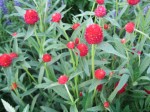 Globe amaranth is an annual in the amaranth family, Amaranthaceae, that also includes Russian thistle, beet, and spinach. Native to Texas and Mexico, it grows 1-3′ tall, depending on the cultivar, and has stiff branching stems and lanceolate leaves that are 3-4″ long, slightly hairy, and almost sessile. The globose flowerheads are up to 1.5″ across and consists of colorful papery petal-like bracts and relatively few tiny yellow flowers. The bracts may be white, lavender, pink, red or magenta. Plants flower all summer long and each flowerhead has a long bloom time. The flowerheads are good in fresh or dried arrangements. The genus name, Gomphrena, was the Latin name for some kind of amaranth plant. The specific epithet, globosa, is the Latin word for spherical, and refers to the form of the flowerhead.
Globe amaranth is an annual in the amaranth family, Amaranthaceae, that also includes Russian thistle, beet, and spinach. Native to Texas and Mexico, it grows 1-3′ tall, depending on the cultivar, and has stiff branching stems and lanceolate leaves that are 3-4″ long, slightly hairy, and almost sessile. The globose flowerheads are up to 1.5″ across and consists of colorful papery petal-like bracts and relatively few tiny yellow flowers. The bracts may be white, lavender, pink, red or magenta. Plants flower all summer long and each flowerhead has a long bloom time. The flowerheads are good in fresh or dried arrangements. The genus name, Gomphrena, was the Latin name for some kind of amaranth plant. The specific epithet, globosa, is the Latin word for spherical, and refers to the form of the flowerhead.
Type: Annual.
Bloom: 1½” globe shaped balls of red bracts bearing tiny yellow flowers from summer into fall.
Size: 1-3’ H x 6-12” W.
Light: Full sun.
Soil: Average, medium moist to dry, well-drained.
Care: Pinch when planting to encourage branching.
Pests and Diseases: Susceptible to gray mold and fungal leaf spots.
Propagation: Seed.
Companion plants: Celosia, vinca, lantana, creeping zinnia, iceplant, portulaca, verbena, sedum.
